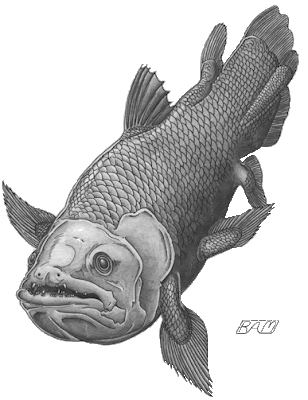 |
| Devonian nature Rekonstruction Mary Parrish |
The following example of modern evolutionary biology explaining excretion in tetrapods has some sentences that I find very suspicious.
The common ancestor of all present gnathostomes lived in freshwater, and later migrated back to the sea. To deal with the much higher salinity in sea water, they evolved the ability to turn the nitrogen waste product ammonia into harmless urea, storing it in the body to give the blood the same osmolarity as the sea water without poisoning the organism. This is the system currently found in cartilaginous fishes and the first bony fishes (acanthodians).
Ray-finned fishes (Actinopterygii) later returned to freshwater and lost this ability, while the fleshy-finned fishes (Sarcopterygii) retained it. Since the blood of ray-finned fishes contains more salt than freshwater, they could simply get rid of ammonia through their gills. When they finally returned to the sea again, they did not recover their old trick of turning ammonia to urea, and they had to evolve salt excreting glands instead.
Lungfishes do the same when they are living in water, making ammonia and no urea, but when the water dries up and they are forced to burrow down in the mud, they switch to urea production. Like cartilaginous fishes, the coelacanth can store urea in its blood, as can the only known amphibians that can live for long periods of time in salt water (the toad Bufo marinus and the frog Rana cancrivora). These are traits they have inherited from their ancestors.
If early tetrapods lived in freshwater, and if they lost the ability to produce urea and used ammonia only, they would have to evolve it from scratch again later. Not a single species of all the ray-finned fishes living today has been able to do that, so it is not likely the tetrapods would have done so either.
Terrestrial animals that can only produce ammonia would have to drink constantly, making a life on land impossible (a few exceptions exist, as some terrestrial woodlice can excrete their nitrogenous waste as ammonia gas). This probably also was a problem at the start when the tetrapods started to spend time out of water, but eventually the urea system would dominate completely.
Because of this it is not likely they emerged in freshwater (unless they first migrated into freshwater habitats and then migrated onto land so shortly after that they still retained the ability to make urea), although some species never left, or returned to, the water could of course have adapted to freshwater lakes and rivers. wikipedia
It seems to me that for the anonymous writer(s) anything goes
- in order to manage the much higher salinity of sea water some animals evolved the ability to change nitrate based ammon into harmless urea. (How on earth did they evolve themselves?)
- bone-finned fish had to evolve salt evicting gills when they returned from fresh water to the sea (How on sea did they evolve themselves?)
- if first tetrapods lived in fresh waters and forgot the ability to produce urea (how?) they would have to be able to evolve this skill again from the beginning (How on lake did they evolve themselves?)
- They were not able to do so. (Who prevented them from evolving a forgotten skill?)
In my opinion there is a Dark evolutionary force of life driving, guiding, blocking and enhancing life forms in different environments.
Dark because this force is not well understood by science. Biologist and paleontologists can only describe what happened and proposed theories why. How exactly, that is another story.
So statements like this are very misleading
They had to evolve salt excreting glands instead. How on earth would those tetrapods do that? By using their brains?
Astrophysicists are humble enough to say that they do presently not know how galaxies accelerate against the well-known rules of gravity that govern the Universe. They work on it and in the meanwhile call it Dark energy. Someday soon science may know more about it.
Instead of nonsensical "the species evolved this and that" biologists should be equally humble and confess that presently we do not know what is life and what is the force that drives it in evolution against the well-known physical laws of entropy that govern the Universe. They work on it and could as well in the meanwhile call it Dark evolution of life. Someday soon science may know much more about it.
Ye Old ID again?
By confessing to ignorance about what makes living things evolve to provide raw materials for natural selection are we trying to introduce Intelligent Design again into the discussion?
Not really.
The difference between respecting the great unknown of evolution and suggesting intelligent design is that ID people do suggest best engineering patterns and other human ideas of how an omnipotent philosopher's god must be taken into account in science as the watchmaker.
Dark evolution of life approach takes life as it has been and is much more seriously than ID theories. History of life as witnessed in fossil record, in life cycles and development of embryos and otherwise in past and existing life forms is there. This is the given life that we can study using the tools and methods and abilities that we have been given. (And I do not mean that in positivist sense!)
From a religious point of view I emphasize that philosopher's gods are like other man made idols and productions of human mind.
The God of Israel is the only real God there is. He has made the extraordinary and outrageous claim that He has made this all. Outrageous because He claims to have created you and me and is going to hold us responsible for how we live our lives here upon planet Earth.



























.png)




















